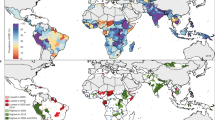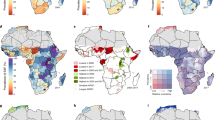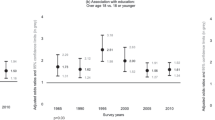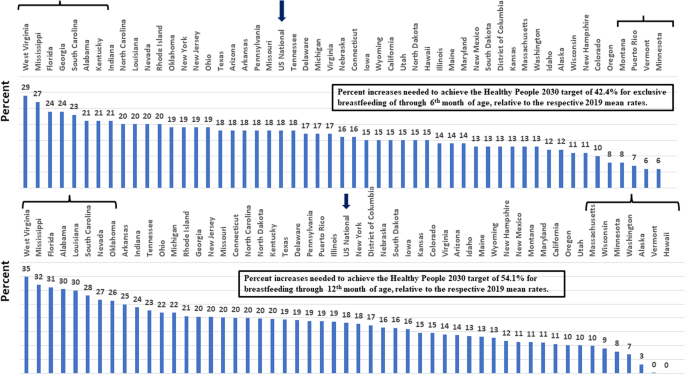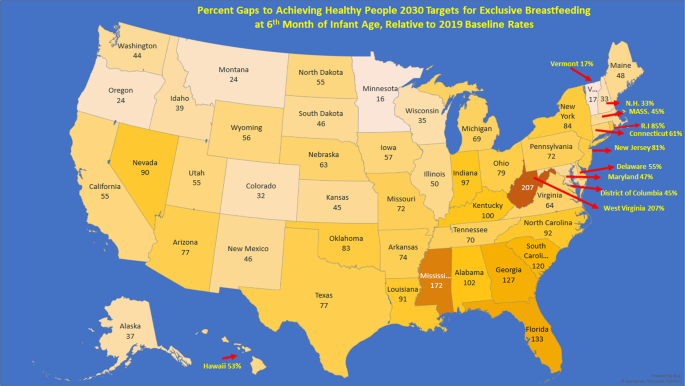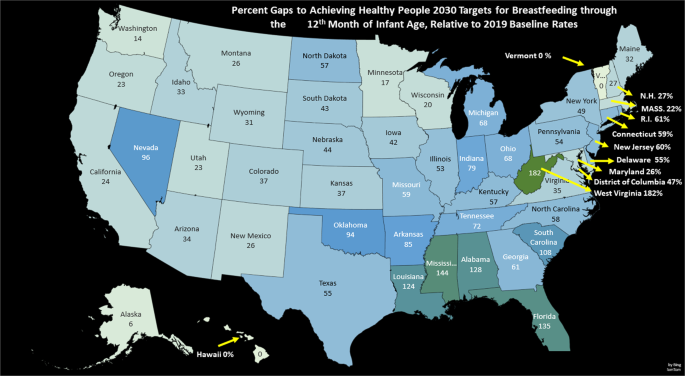Abstract
Objectives
To estimate the national and states-specific gaps in breastfeeding rates in the United States for achieving the Healthy People 2030 (HP2030) targets, which are: 42.4% of infants to exclusively breastfeed through 6th months, and 54.1% of infants to breastfeed through 12th month of age.
Study design
The differences between the HP2030 breastfeeding targets and the respective state-specific baseline rates in the 2022 National Immunization Survey report for infants born in 2019 were computed.
Results
The gaps in breastfeeding rates for achieving either of the two HP2030 targets varied greatly. Relative to their 2019 baseline estimates, 7 U.S. states need to increase breastfeeding rates between 100% and 207%, 27 states between 50% and 99%, 9 states and 2 territories between 20% and 49% and the remaining 7, between 0% and 19%.
Conclusions
Thirty-four of 50 (68%) states face huge gaps in achieving the HP2030 breastfeeding targets.
Similar content being viewed by others
Introduction
The Healthy People 2030 (HP2030) program has set national objectives for the United States to increase the proportion of infants to exclusively breastfeed through 6th months of age to 42.4% (6-month target), and to continue breastfeeding through 12th month of age to 54.1% (12-month target) [1]. Exclusive breastfeeding is defined as feeding only breastmilk, no solids, and no water or no other liquids.
The Healthy People Program is a U.S. Federal Government effort, which develops health-related targets for the nation to achieve every 10 years. To formulate the HP2030 breastfeeding targets, the Program used earlier data from the National Immunization Survey (NIS) conducted by the Centers for Disease Control and Prevention (CDC), along with extensive literature reviews, and motivated by a desire to advance the health of the nation.
Since continued breastfeeding offers numerous health benefits to the mother and her infant, the American Academy of Pediatrics Section on Breastfeeding has issued a new policy statement retaining its endorsement for exclusive breastfeeding through 6th month, and continued breastfeeding for at least 12 months. Now the policy also recommends continued breastfeeding as long as mutually desired by the mother and the child for 2 years or beyond [2].
Although the breastfeeding initiation rates are high in the U.S., most women do not breastfeed exclusively for the first 6 months, or continue to breastfeed their infants through the first 12 months, as reported by the latest NIS released on August 1, 2022 [3]. Among the infants born in 2019, the national rate estimate for 6th month exclusive breastfeeding was 24.9% and the estimate for breastfeeding through the 12th month was 35.9%, with wide variation among the states [3].
Therefore, for achieving the HP2030 targets, many states may need to overcome substantial gaps in breastfeeding rates. However, the extent of state-specific gaps has not been reported. This study assesses the state and territory-specific gaps in breastfeeding rates for achieving the HP2030 targets.
Materials and methods
The results from the 2022 NIS data [3] were used for analyses in this study. The NIS results provide the national, state, and territory-level breastfeeding estimates for 2019 live births for all 50 states, Puerto Rico, and the District of Columbia (henceforth referred to as “states”).
The NIS adapts a random-digit-dialling, complex sampling method for the survey to estimate the current national, state, selected local level, and some US territory level vaccination coverage rates for US infants and children. Since July 2001, breastfeeding questions have been added to the NIS to monitor rates of breastfeeding at national and state levels by birth year. The 2022 NIS report contains responses from the members of households with children aged 19–35 months, and who were born in 2019 calendar year.
The NIS determines the sample sizes to provide the statistical precision required to estimate vaccination coverage as well as breastfeeding prevalence for each survey area. The NIS webpage provides additional details about the survey methods and analytical techniques [4].
The NIS does not collect information on gestational age. However, the inclusion of preterm births in the survey of households with surviving infants at 19–35 months is unlikely to have affected the overall rates of breastfeeding. This is because, in 2019, 10.23% of U.S. births were preterm, and 0.66% were extremely preterm (<28 weeks of gestation) [5]. These are small numbers among the relatively small survey samples that ranged between 250 and 1200.
Two methods were used to express gaps in achieving the HP2030 targets. One was by subtracting the target rates from the 2019 respective state-specific breastfeeding estimates [3], and the second was calculating the percentage differences relative to state’s 2019 baseline rates. As for example: In 2019, 27.3% of infants born in California were exclusive breastfed through 6 months of age. Therefore, to achieve the HP2030 6-month target of 42.4%, California must overcome a 15.1% gap, or 55.3% gap relative to the state’s 2019 baseline (15.1/27.3 × 100 = 55.3%).
As its usual practice, NIS publishes the national and state-specific breastfeeding rates as mean ± ½ of 95% confidence intervals (CI) due to the relatively small sample sizes and large CIs [3], which was retained while reporting the results in this paper. However, to test the statistical significance among the states, the widths of the mean ± full 95% CIs were compared. If the widths overlapped, the respective mean values were declared not to be significantly different from each other, and if they did not overlap, they were declared to be significantly different.
Results
Table 1 provides the number of responses to the 2022 NIS survey along with the national and state-specific mean rates (±one-half of 95% CI) [3]. The results are sorted in an ascending order for the mean breastfeeding values for the 6th and 12th month breastfeeding estimates. The table footnote also lists the states and territories that had achieved HP2020 targets by 2019.
The state-specific rates for the two breastfeeding measures of interest varied greatly. The 6th month exclusive breastfeeding rate was the lowest for West Virginia, and highest for Minnesota. Similarly, the 12th month breastfeeding rate was lowest for West Virginia and highest for Hawaii (which had already achieved the 12th month target of 54.1%).
Figure 1 shows the gaps for achieving the 6th and 12th month targets. The U.S. national gaps for the two targets (arrows) were: 17.5% and 18.2%, respectively (rounded to 18%). Figure 1 also show that the extent of gaps for achieving the two HP2030 targets ranged greatly among the states. The states within the parenthetic marks at the left ends of the graphs need to overcome significantly larger gaps compared to those in the parenthetic marks at the right ends of the graphs.
The percent gaps for achieving the HP2030 targets for exclusive breastfeeding through the 6th month (upper panel) and breastfeeding though the 12th month (lower panel). The differences between the respective target values and the 2019 baseline mean rates for the U.S. (arrows), 50 individual states, Puerto Rico and the District of Columbia, arranged in descending order from left to right. The gaps among the states within the parenthetic marks at two ends of both graphs were significantly different. These states were—to achieve the 6-month target (upper panel), West Virginia, Mississippi, Florida, Georgia, South Carolina, Alabama, and Kentucky (left end of the graph) encounter significantly larger gaps compared to those of Montana, Puerto Rico, Vermont, and Minnesota (right end of the graph); to achieve the 12-month target (lower panel), West Virginia, Mississippi, Florida, Alabama, Louisiana, South Carolina, Nevada, and Oklahoma (left end of the graph) encounter significantly larger gaps compared to those of Massachusetts, Wisconsin, Minnesota, Washington, Alaska, Vermont, and Hawaii (right end of the graph). The data were rounded using the general algebraic rules.
Figures 2 and 3 show the geographic distribution of the percentage gaps relative to their respective 2019 mean rates. Both figures show that the gaps for achieving the HP2030 breastfeeding targets vary greatly. The gaps to achieve either of the targets ranged between 100% and 207% for 7 states; between 50% and 99% for 27 states; between 20% and 49% for the 9 states and 2 territories; and between 0% and 19% for the remaining 7 states. The gaps were higher in the southern, industrial eastern, and midwestern states compared to those in the Atlantic-northeastern, northern, and Pacific northwestern states.
Discussion
The results of this study (Table 1 and Figs. 1–3) show that a large number of U.S. states face huge gaps for achieving the HP2030 breastfeeding targets [3]. Therefore, these states may need to develop regional programs for enhancing continued breastfeeding for achieving the worthy goals of HP2030.
Why such a large variation in the gaps to achieve the HP2030 targets? The obvious reason is the variation in the baseline breastfeeding rates. And explaining regional variations in breastfeeding requires data on the distribution of associated variables noted above across the states. Such data are not available, and studies are urgently needed to rectify this knowledge gap.
Even in states with high mean breastfeeding rates, there could be regions having suboptimal breastfeeding rates. Thus, addressing the generic and local factors impeding the continuation of breastfeeding would be critical to achieving 2030 breastfeeding targets—a ‘one-size fits all’ approach may not work.
The NIS survey [3] identified several specific socio-demographic factors such as gender, race/ethnicity, maternal education, maternal age, poverty-to-income ratio, marital status, and geographic location affecting breastfeeding continuation in the U.S. (Table 2). Race and ethnicity are also important factors affecting breastfeeding continuation beyond the immediate postpartum period, as shown in the supplementary material Table.
Other factors known to negatively influence the duration of breastfeeding include mode of delivery, work and workplace issues, the unavailability of lactation consultants especially in rural areas have also been noted as factors negatively affecting breastfeeding durations [6].
Improving breastfeeding rates can also help achieve another HP2030 target—reducing the U.S. infant mortality rate (IMR) to 5.0 deaths for 1000 live births [1]. A recent study from the CDC using linked birth and death certificates reported that “any” breastfeeding resulted in a 26% reduction in post-perinatal deaths in the U.S. [7] This is the first report to show an association between breastfeeding and reduced IMR in an industrialized nation, such as the U.S.
How to enhance continued breastfeeding beyond the immediate postpartum period? Two recent studies highlight potential opportunities. Using a sample of 33,121, Kogan et al. [8] showed that the prevalence of infants “ever breastfed” and “breastfed for at least six months” were higher in states that have enacted one or more legislative policies geared to promoting breastfeeding. They also noted that sociodemographic and maternal factors did not account for most of the variations in the breastfeeding rates [8].
In another study, the researchers examined the associations between workplace leave length and breastfeeding initiation and continuation at 1, 2, and 3 months in a cohort of 12,301 postpartum women [9]. Approximately two thirds (66.2%) of women reported taking less than 3 months of leave. A shorter leave length (<3 months), paid or unpaid, was associated with lower prevalence of continued breastfeeding at 2 and 3 months of postpartum. These findings support the expert opinion that regional laws and legislative policies positively influence breastfeeding rates [10].
Besides the length of postpartum maternal leave, a friendly workplace environment would be conducive to continued breastfeeding, just as an unfriendly workplace environment would be detrimental [11,12,13,14,15]. Similarly, advertising commercial formulas in the prenatal clinics had a negative impact on the duration of breastfeeding [16]. South African scientists report that many infant formula manufacturing companies have been using a variety of covert marketing techniques to entire women to stop breastfeeding and purchase commercial infant formula to feed their infants [17].
Hospitals caring for postpartum women could require all units to have standardized counseling sessions, and to the extent possible, offer help to overcome barriers to continued breastfeeding for individual families. The hospitals might also implement the Ten Steps to Successful Breastfeeding recommended by the Baby-Friendly USA [18].
Strengths of this study include the use of the latest NIS data [3] to compute the gaps in breastfeeding rates for achieving the HP2030 targets [1]. However, this study has limitations. The baseline breastfeeding data were obtained from a cohort of women delivering live births in the 2019 calendar year. Therefore, it is possible that the rates could have improved since then and the actual gaps reported here could be overestimates.
Additionally, the target year of birth for the 2022 NIS survey was 2019—before the outbreak of COVID-19 pandemic. The potential impact of the pandemic-related adverse effects such as shut down, social isolation, loss of job and income on breastfeeding practices remain to be studied. It is possible that the enforced stay-at-home policies might have encouraged more women to breastfeed for longer durations. However, poverty, food insecurity and depression due to the pandemic-related isolation might have had an opposite effect on breastfeeding practices. These issues are important topics for future studies.
In conclusion, the data presented in this study show that 34/50 (68%) states in the U.S., need to overcome significant gaps, and Puerto Rico and the District of Columbian need to overcome modest gaps for achieving the 2030 Healthy People breastfeeding targets. Understanding the state and region-specific barriers, implementing remedial measures, and developing policies and regulations to support breastfeeding services could be invaluable in helping to overcome those gaps and achieve the HP2030 targets, positively impacting the nation’s health.
Data availability
The author is willing to share the data used in this manuscript, available as Microsoft Excel files.
Change history
11 November 2022
A Correction to this paper has been published: https://doi.org/10.1038/s41372-022-01561-9
References
U.S. Department of Health and Human Services. Office of Disease Prevention and Health Promotion. Healthy People 2030. Healthy People, Nutrition and Health Policy 2021. https://health.gov/healthypeople/objectives-and-data/browse-objectives/nutrition-and-healthy-eating. Accessed 12 Nov 2021.
Meek JY, Noble L. Technical Report: breastfeeding and the use of human milk. Pediatrics, 2022:150.
Centers for Disease Control and Prevention. Results: Breastfeeding Rates: Breastfeeding Among U.S. Children Born 2012-2019, CDC National Immunization Survey: Results,. National Immunization Survey (NIH). 2022. https://www.cdc.gov/breastfeeding/data/nis_data/results.html. Accessed 2 Aug 2022.
Centers for Disease Control and Prevention. National Immunization Survey--Methods. National Immunization Survey, 2021. https://www.cdc.gov/vaccines/imz-managers/nis/methods.html. Accessed 12 Nov 2021.
Martin JA, Hamilton BE, Osterman MJK, Driscoll AK. Births: final data for 2019. Natl Vital- Stat Rep. 2021;70:1–50.
Anstey EH, Chen J, Elam-Evans LD, Perine CG. Racial and geographic differences in breastfeeding—United States, 2011–2015. Morb Mortal Wkly Rep. 2017;66:723–7.
Li R, Ware J, Chen A, Nelson JM, Kmet J, Park SE, et al. Breastfeeding and post-perinatal infant deaths in the united states, a national prospective cohort analysis. Lancet Regional Health—Am. 2022;5:1–14.
Kogan MD, Singh GK, Dee DL, Belanoff C, Grummer-Strawn LM. Multivariate analysis of state variation in breastfeeding rates in the United States. Am J Public Health. 2008;98:1872–80.
Kortsmit K, Li R, Cox S, Shapiro-Mendoza CK, Perine CG, D’Angelo DV, et al. Workplace leave and breastfeeding duration among postpartum women, 2016-2018. Am J Public Health. 2021;111:2036–45.
Barraza, L, Lebedevitch C, Stuebe A. The role of law and policy in assisting families to reach healthy people’s maternal, infant, and child health breastfeeding goals in the United States. Healthy People, USA 2020. https://www.healthypeople.gov/2020/law-and-health-policy/topic/maternal-infantchild-health. Accessed 19 Nov 2021.
Raju TN. Continued barriers for breast-feeding in public and the workplace. J Pediatr. 2006;148:677–9.
Raju TN. Reasonable break time for nursing mothers: a provision enacted through the Affordable Care Act. Pediatrics. 2014;134:423–4.
Whitley MD, Ro A, Choi B. Workplace breastfeeding support and job satisfaction among working mothers in the United States. Am J Ind Med. 2019;62:716–26.
Steurer LM. Maternity leave length and workplace policies’ impact on the sustainment of breastfeeding: global perspectives. Public Health Nurs. 2017;34:286–94.
Lynch S. Breastfeeding and the workplace. Community Pract. 2016;89:29–31.
Howard C, Howard F, Lawrence R, Andersen E, DeBlieck E, Weitzman M. Office prenatal formula advertising and its effect on breast-feeding patterns. Obstet Gynecol. 2000;95:296–303.
Pereira-Kotze C, Honwood C, Haskins L, Kingston G, Luthuli S, Doherty T. Exploring women’s exposure to marketing of commercial formula products: a qualitative marketing study from two sites in South Africa. Glob Health Action. 2022;15:2074663
Baby Friendly USA Inc. The Ten Steps to Successful Breastfeeding. The Baby-Friendly Hospital Initiative 2021. https://www.babyfriendlyusa.org/for-facilities/practice-guidelines/10-steps-and-international-code/. Accessed 21 Nov 2021.
Acknowledgements
The author thanks Ruowei Li, MD, PhD, the Centers for Disease Control and Prevention, Division of Nutrition, Physical Activity, and Obesity, Atlanta, GA, for help with explaining NIS survey and statistical methods. He also thanks Ms. Brigit Sullivan, MLS, Biomedical Librarian, NIH Library, Bethesda, MD for help with editing.
Author information
Authors and Affiliations
Contributions
TNKR conceived the study, carried out the data analyses, interpreted the results, and wrote the manuscript.
Corresponding author
Ethics declarations
Competing interests
The author is the Deputy Editor for the Journal of Perinatology. The author is Program Officer in the Office of the Director, National Institutes of Health. However, the opinions presented in this paper are those of the author alone. They do not necessarily represent those of the US Government, the Department of Health and Human Services, or the National Institutes of Health.
Additional information
Publisher’s note Springer Nature remains neutral with regard to jurisdictional claims in published maps and institutional affiliations.
The original online version of this article was revised: In the abstract, in the introduction, in the results and in table 2, some sentences have been revised.
Supplementary information
Rights and permissions
About this article
Cite this article
Raju, T.N.K. Achieving healthy people 2030 breastfeeding targets in the United States: challenges and opportunities. J Perinatol 43, 74–80 (2023). https://doi.org/10.1038/s41372-022-01535-x
Received:
Revised:
Accepted:
Published:
Issue Date:
DOI: https://doi.org/10.1038/s41372-022-01535-x

